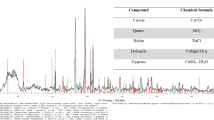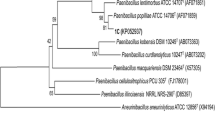Abstract
Biochemical and pharmacological properties of biosurfactants produced at 45°C temperature by Pseudomonas aeruginosa mucoid (M) and non-mucoid (NM) strains, isolated from hydrocarbon-contaminated soil samples, were characterized. Both the strains secreted appreciable amount of biosurfactants (5.0–6.5 g/l), responsible for the reduction of surface tension of the medium from 68 to 29±0.5 mN/m post 96 h of growth. Maximum yield of biosurfactants was observed following the supplementation of NH4Cl and glycerol as nitrogenous source and carbon source, respectively. These thermostable biosurfactants exhibited strong emulsifying property and could release appreciable amount of oil from saturated sand-pack column. Pharmacological characterization of these biosurfactants revealed that they induced dose-dependent hemolysis and coagulation of platelet-poor plasma but were non-detrimental to chicken lung, liver, heart and kidney tissues. Our study has documented that biosurfactants from P. aeruginosa M and NM strains could be exploited for use in petroleum sectors as well in pharmaceutical industries.


Similar content being viewed by others
References
Abu-Ruwaida AS, Banat IM, Haditirto S, Saleem A, Kadri M (1991) Isolation of biosurfactant-producing bacteria product characterization and evaluation. Acta Biotechnol 11:315–324
Banat IM (1993) The isolation of a thermophilic biosurfactant producing Bacillus sp. Biotechnol Lett 15:591–594
Banat IM (1995) Biosurfactants production and possible uses in microbial enhanced oil recovery and oil pollution remediation: a review. Bioresour Technol 51:1–12
Barsotti O, Decoret D, Renaud FNR (2002) Identification of Streptococcus mitis group species by RFLP of the PCR-amplified 16S–23S rDNA intergenic spacer. Res Microbiol 153:687–691
Benincasa M, Abalos A, Oliveria I, Manresa A (2004) Chemical structure, surface properties and biological activities of the biosurfactant produced by Pseudomonas aeruginosa LBI from soapstock. Antonie van Leeuwenhoek 85:1–8
Bonmatin J-M, Laprevote O, Peypoux F (2003) Diversity among microbial cyclic lipopeptides: iturins and surfactins. Activity–structure relationships to design new bioactive agents. Comb Chem High Throughput Screen 6:541–556
Cameotra SS, Makkar RS (2004) Recent applications of biosurfactants as biological and immunological molecules. Curr Opin Microbiol 7:1–5
Cappuccino JG, Sherman N (1999) Microbiology—a laboratory manual. Addison-Wesley Longman, Inc
Chayabutra C, Ju L-K (2001) Polydrooxyalkanoic acids and rhamnolipids are synthesized sequentially in hexadecane fermentation by Pseudomonas aeruginosa ATCC 10145. Biotechnol Prog 17:419–423
Cooper DG, Goldenberg BG (1987) Surface active agents from two Bacillus species. Appl Environ Microbiol 53:224–229
Das K, Doley R, Mukherjee AK (2004) Purification and biochemical characterization of a thermostable, alkaliphilic, extracellular α-amylase from Bacillus subtilis DM-03, isolated from the traditional fermented food of India. Biotechnol Appl Biochem 40:291–298
Desai JD, Banat IM (1997) Microbial production of surfactants and their commercial potential. Microbiol Mol Biol Rev 61:47–64
Doley R, Mukherjee AK (2003) Purification and characterization of an anticoagulant phospholipase A2 from Indian monocled cobra (Naja kaouthia) venom. Toxicon 41:81–91
Francy DS, Thomas JM, Raymond RL, Ward CH (1991) Emulsification of hydrocarbons by subsurface bacteria. J Ind Microbiol 8:237–246
Haba E, Pinazo A, Jauregui O, Espuny MJ, Infante MR, Manresa A (2003) Physicochemical characterization and antimicrobial properties of rhamnolipids produced by Pseudomonas aeruginosa 47T2 NCBIM 40044. Biotechnol Bioeng 81:316–322
Hirota Y (1960) The effect of acridine dyes on mating type factors in E. coli. Proc Natl Acad Sci U S A 46:57–64
Jensen MA, Webster JA, Straus N (1993) Rapid identification of bacteria on the basis of polymerase chain reaction-amplified ribosomal DNA spacer polymorphisms. Appl Environ Microbiol 59:945–952
Johnson MK, Boese-Marrazzo D (1980) Production and properties of heat-stable extracellular hemolysin from Pseudomonas aeruginosa. Infect Immun 29:1028–1033
Kim SH, Lim EJ, Lee SO, Lee JD, Lee TH (2000) Purification and characterization of biosurfactant from Nocardia sp. L-417. Biotechnol Appl Biochem 31:249–253
Maier RM (2003) Biosurfactant: evolution and diversity in bacteria. Adv Appl Microbiol 52:101–121
Makkar RS, Cameotra SS (1998) Production of biosurfactant at mesophilic and thermophilic conditions by a strain of Bacillus subtilis. J Ind Microbiol Biotechnol 20:48–52
Mulligan CN (2005) Environmental applications of biosurfactants. Environ Pollut 133:183–198
Mukherjee AK, Maity CR (2002) Biochemical composition, lethality and pathophysiology of venom from two cobras—Naja naja and Naja kaouthia. Comp Biochem Physiol B Biochem Mol Biol 131:125–132
Mukherjee AK, Ghosal SK, Maity C (1998) Effect of oral supplementation of vitamin E on the hemolysis and erythrocyte phospholipid-splitting action of cobra and viper venom. Toxicon 36:657–664
Nielsen TH, Sorensen D, Tobiasen C, Andersen JB, Christophersen C, Givskov M, Sorensen J (2002) Antibiotic and biosurfactant properties of cyclic lipopeptides produced by fluorescent Pseudomonas spp. from the sugar beet rhizosphere. Appl Environ Microbiol 68:3416–3423
Pruthi V, Cameotra SS (1995) Rapid method for monitoring maximum biosurfactant produced by acetone precipitation. Biotechnol Tech 9:271–276
Pruthi V, Cameotra SS (1997) Production of a biosurfactant exhibiting excellent emulsification and surface active properties by Serratia marcescens. World J Microbiol Biotechnol 13:133–135
Ron EZ, Rosenberg E (2002) Biosurfactants and oil bioremediation. Curr Opin Biotechnol 13:249–252
Sambrook J, Fritsch EF, Maniates T (1989) In: Nolan C (ed) Molecular cloning 1, 2nd edn. Cold Spring Harbor Laboratory Press, New York
Singh P, Cameotra SS (2004) Potential applications of microbial surfactants in biomedical sciences. Trends Biotechnol 22:142–146
Stackebrandt E, Goebel B (1994) Taxonomic note. A place for DNA–DNA reassociation and 16S rRNA sequence analysis in the present species definition in bacteriology. Int J Syst Bacteriol 44:846–849
Syldatk C, Lang S, Wanger F (1985) Chemical and physicalcharacterization of four interfacial active rhamolipids from Pseudomonas sp. DSM 2874 grown on n-alkanes. Z Naturforsch 40C:51–60
Turkovskaya OV, Dmitrieva TV, Muratova AY (2001) A biosurfactant-producing Pseudomonas aeruginosa strain. Appl Biochem Microbiol 37:71–75
Vater J, Kablitz B, Wilde C, Franke P, Mehta N, Cameotra SS (2002) Matrix-assisted laser desorption ionization-time of flight mass spectrometry of lipopeptide biosurfactants in whole cells and culture filtrates of Bacillus subtilis C-1 isolated from petroleum sludge. Appl Environ Microbiol 68:6210–6219
Yuste L, Corbella ME, Turiegano MJ, Karlson U, Puyet A, Rojo F (2000) Characterization of bacterial strains able to grow on high molecular mass residues from crude oil processing. FEMS Microbiol Ecol 32:69–75
Acknowledgements
We are grateful to Dr. Anil K. Lala, Indian Institute of Technology, Mumbai, and Dr. P. Deepalakshmi, Indian Institute of Science, Bangalore, for MALDI-TOF analysis and Dr. S.M. Raj, Institute of Microbial Technology, Chandigarh, for GC analysis of bacterial FAMEs. The authors are thankful to Prof. P.C. Deka and Prof. B.K. Konwar, Tezpur University, for their useful suggestions and constant encouragement to pursue the present work. K. Das was a recipient of Senior Research Fellowship from ONGC sponsored Center for Petroleum Biotechnology, Department of Molecular Biology and Biotechnology, Tezpur University.
Author information
Authors and Affiliations
Corresponding author
Rights and permissions
About this article
Cite this article
Das, K., Mukherjee, A.K. Characterization of biochemical properties and biological activities of biosurfactants produced by Pseudomonas aeruginosa mucoid and non-mucoid strains isolated from hydrocarbon-contaminated soil samples. Appl Microbiol Biotechnol 69, 192–199 (2005). https://doi.org/10.1007/s00253-005-1975-5
Received:
Revised:
Accepted:
Published:
Issue Date:
DOI: https://doi.org/10.1007/s00253-005-1975-5




